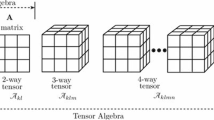Abstract
In this paper, we proposed a novel classification method for face recognition which adopts the functionalities of linear discriminant and regression. Linear discriminant and regression analysis methods have benefits regarding minimising time, memory usage and better feature extraction. Linear regression and discriminant classification (LRDC) makes use of the principle that a sample class lie in a linear subspace, proposed method represents a predicted image as a linear combination of class-specific galleries. LRDC belongs to the category of nearest subspace classification and finds the set of optimal discriminant projection vectors by adopting singular value decomposition (SVD) and null space, and the decision made for a class with the minimum distance. LRDC is extensively evaluated by applying it to different classified datasets and compared with the state-of-the-art algorithms.









Similar content being viewed by others
References
Ragul, G., Magesh Kumar, C., Thiyagarajan, R., Mohan, R.: Comparative study of statistical models and classifiers in face recognition. In: Proceedings of IEEE International Conference on Information Communication and Embedded Systems (ICICES), pp. 623–628 (2013). https://doi.org/10.1109/icices.2013.6508221
Witten, Ian H., Frank, Eibe, Hall, MarkA, Pal, Chirstopher J.: Data Mining: Practical Machine Learning Tools and Techniques. Morgan Kaufmann, Burlington (2005). ISBN 978-0-12-804291-5
Larose, D.T.: k-nearest neighbour algorithm. In: Discovering Knowledge in Data: An Introduction to Data Mining, pp. 90–106 (2005). https://doi.org/10.1002/0471687545.ch5
Zhang, N., Yang, J., Qian, J.: Component-based global K-NN classifier for small sample size problems. Pattern Recogn. Lett. 33(13), 1689–1694 (2012)
Abdi, H., Williams, L.J.: Principal component analysis. Wiley Interdiscip. Rev. Comput. Stat. 2(4), 433–459 (2010)
Li, M., Yuan, B.: 2D-LDA: a statistical linear discriminant analysis for image matrix. Pattern Recogn. Lett. 26(5), 527–532 (2005)
Gu, Q., Li, Z., Han, J.: Linear discriminant dimensionality reduction. In: Chapter Machine Learning and Knowledge Discovery in Databases. LNCS, vol. 6911, pp. 549–564 (2011). https://doi.org/10.1007/978-3-642-23780-545
Mi, J.-X., Liu, J.-X., Wen, J.: New robust face recognition methods based on linear regression. PLoS ONE 7(8), 1–10 (2012). https://doi.org/10.1371/journal.pone.0042461
Bhattacharyya, S.K., Rahul, K.: Face recognition by linear discriminant analysis. Int. J. Commun. Netw. Secur. 2(2), 31–35 (2013)
Chang, C.Y., Chuan-Wang, C., Hsieh, C.Y.: Applications of blocklinear discriminant analysis for face recognition. J. Inf. Hiding Multimed. Signal Processing 2(3), 259–269 (2011)
Liu, J., Chen, S., Tan, X.: A study on three linear discriminant analysis based methods in small sample size problem. Pattern Recogn. 41(1), 102–116 (2008)
Ye, J., Xiong, T.: Computational and theoretical analysis of null space and orthogonal linear discriminant analysis. J. Mach. Learn. Res. 7, 1183–1204 (2006)
Wang, B., Li, W., Li, Z., Liao, Q.: Adaptive linear regression for single-sample face recognition. Neurocomputing 115, 186–191 (2013)
Jaganathan, S., Stepan, P.: Linear regression for pattern recognition. In: IEEE Conference on Green Computing Communication and Electrical Engineering (ICGCCEE), pp. 1–6 (2014). https://doi.org/10.1109/icgccee.2014.6921393
Zhong, J., Yi, C.: Reconstructive discriminant analysis: a feature extraction method induced from linear regression classification. Neurocomputing 87, 41–50 (2012)
Delin, C., Thye, G.S.: A new and fast implementation for null space-based linear discriminant analysis. Pattern Recogn. 43(4), 1373–1379 (2009). https://doi.org/10.1016/j.patcog.2009.10.004
Lua, G.-F., Zheng, W.: Complexity-reduced implementations of complete and null-space-based linear discriminant analysis. Neural Netw. 46, 165–171 (2013). https://doi.org/10.1016/j.neunet.2013.05.010
Samaria, F.S., Harter, A.C.: Parameterisation of a stochastic model for human face identification. In: Proceedings of 2nd IEEE Workshop on Applications of Computer Vision, Sarasota, FL (1994)
Naseem, I., Togneri, R., Bennamoun, M.: Linear regression for face recognition. IEEE Trans. Pattern Anal. Mach. Intell. 32(11), 2106–2112 (2010)
Author information
Authors and Affiliations
Corresponding author
Rights and permissions
About this article
Cite this article
Prasad, D.V.V., Jaganathan, S. Null-space based facial classifier using linear regression and discriminant analysis method. Cluster Comput 22 (Suppl 4), 9397–9406 (2019). https://doi.org/10.1007/s10586-018-2178-z
Received:
Revised:
Accepted:
Published:
Issue Date:
DOI: https://doi.org/10.1007/s10586-018-2178-z




